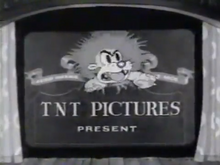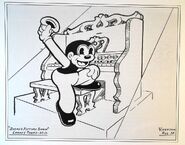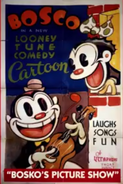Warning! This page contains content that can be seen as mature or inappropriate for younger audiences. Please continue at your own risk.
Bosko's Picture Show is a 1933 Looney Tunes short directed by Hugh Harman and Isadore Freleng.
Plot[]
In a movie theater, curtains and barn doors open to reveal a movie screen. The screen introduces the host of the movie show, Bosko, who is playing a "Furtilizer" organ. Bosko leads the audience in the song "We're in the Money".[4]
A newsreel called Out-of-Tone News plays with the accompanying tagline "Sees All, Hears All, Smells All". Various scenes of world news appear. The first of them takes place in Geneva, where a peace conference is taking place. Actually the attending world leaders are engaging in hand-to-hand combat, while a ring announcer gives a blow-by-blow description of the action.[4] The following scene takes place in Malibu, California. A title card reports that it is about the Sunkist Bathing Beauties enjoying the sunshine of California. The scene then contradicts the card by depicting a single, unattractive woman on a beach during a snowstorm, attempting to evade a tidal wave.[4] The next scene takes place in Reno, Nevada, where boxer "Jack Dumpsey" is reported training for a comeback. He is a "withered old man with a cane".[4] Following is a scene taking place in Espom Salts, England, depicting a race among blue-blood dogs. The defending champion Bruno, Bosko's pet dog, is sniffing around and trailing his competitors, until he finds himself chased by the Marx Brothers, equipped as dog catchers.[4]
The final scene of the newsreel takes place in Germany, where Adolf Hitler is depicted pursuing Jimmy Durante with a meat cleaver or axe in hand. Hitler is depicted as a ruthless and violent buffoon, wearing lederhosen and an armband depicting a swastika. Durante shouts his catchphrase "Am I mortified!". The newsreel then ends with the tagline It Squeaks for Itself.
The newsreel is followed by a short subject parodying Laurel and Hardy, who are called here "Haurel and Lardy", starring in "Spite of Everything". The two comedians find a cooling pie on a window sill and steal it. Then they argue over ownership of the pie. The pie switches hands many times, until Haurel ends their rivalry by pieing Lardy. In retaliation, Lardy uses a discarded pot to hit Haurel. The subject ends with Haurel crying.[4]
The last film of the show follows. It is a "TNT Pictures" production, its logo featuring a roaring (and burping) lion. The film itself is a melodrama set in the 1890s, entitled "He Done Her Dirt (and How!)".[4] Honey, Bosko's girlfriend, is riding a bicycle. She is followed by the Marx Brothers, who sing "Bicycle Built for Two" (1892). Then a title card introduces the villain, "Dirty Dalton (The Cur!)".[4] Bosko sees this and yells what seems to have possibly been a curse word (see below). Dalton hides behind a tree and manages to ambush Honey, abducting her. He then "leaps off a cliff and onto a train passing underneath", ending with his victim on top of a runaway railroad car. Honey breaks the fourth wall by asking for assistance from the audience. Bosko volunteers to save her and leaps towards the screen. He fails to enter the world of the 1890s film and goes through the screen. But his efforts leave a hole where Dalton's head should be, disabling the villain and somehow rescuing Honey. Honey applauds, and Bosko reappears from behind the screen, and raises his hands in triumph.[4]
Caricatures[]
- Peggy Hopkins Joyce
- Jack Dempsey - as Jack Dumpsey
- The Marx Brothers
- Adolf Hitler
- Jimmy Durante
- Stan Laurel and Oliver Hardy
- Ted Lewis - "Is everybody happy?"
Availability[]
Looney Tunes Golden Collection: Volume 6, Disc 3 (restored) (audio is uncut and uncensored, though the captions have "The dirty fawk!" down as "The dirty fox!")
Controversy[]
- Pre-Hays Code Hollywood films (both animated and live-action) were notorious for pushing the boundaries of what was considered taboo at the time, particularly when it comes to sexuality (specifically female sexuality), moral ambiguity, racial issues (including interracial romance and sex), criticizing and mocking so-called "sacred" institutions (mostly marriage, government, and religion), and, most importantly, the use of profanity and crude expressions. "Bosko's Picture Show" has come under fire in recent years for its possible use of profane language and how it brazenly got away with it under the eye of the Hays Code.
- When the villain first appears onscreen, Bosko shouts what sounds like "The dirty fuck!" Because the word is not clearly heard, it has been argued that a soundtrack flaw rendered a more "polite" phrase, such as "dirty fox" or "dirty mug", into an obscene one.[5] Mark Kausler has studied the lip movements of the character and insisted that "mug" was the intended word. He initially believed that the sound flaw only appeared on the 16 mm film version, and tried to record the sound off a 35 mm nitrate film to correct this. This did nothing to solve the problem; listeners still heard the disputed word as "fuck".[6] Animation historian Jerry Beck had several people see the film, and they all concluded that Bosko called the movie villain a "dirty fuck."
Censorship[]
When this short was shown on Nickelodeon's Nick at Nite version of Looney Tunes on Nick, the following was edited:
- The newsreel scene showing Adolf Hitler chasing Jimmy Durante with a meat cleaver was cut.
- Bosko's infamous line about the movie villain, "The dirty fock!" (which sounds dangerously close to the actual "f"-word and has been argued as such by many animation historians and fans) had "fock" replaced with "cur" (which was used near the end when Bosko says, "Stop, you cur!") starting with the second time this short aired.[5]
Notes[]
- The "Furtilizer" organ is a play on the name Wurlitzer, as Wurlitzer pipe organs were regularly used in theaters of the time.
- The newsreel Out-of-Tone News and its slogan are a reference to Movietone News, which had the slogan Sees all, Hears All, Knows All.[4]
- Its tagline is a reference to another slogan of Movietone News: "It Speaks for Itself".[4]
- The roaring and burping lion is a reference to Leo the Lion, the mascot of Metro-Goldwyn-Mayer.[4] Ironically, Bosko would later be used in MGM cartoons after Harman and Ising left Warner Brothers.
- This is the last Looney Tunes short produced by Hugh Harman and Rudolf Ising for Leon Schlesinger Productions and Warner Bros. The duo moved on to produce cartoons for Metro-Goldwyn-Mayer, the first of which were released in the following year.
- It is also the final appearance of Bosko and Honey in a Looney Tunes cartoon. The duo would not appear again in any Warner Brothers work until the 1990 Tiny Toon Adventures episode "Fields of Honey".
- This is the final short that Bernard B. Brown did the editing and sound effects by himself; beginning with the next short, "Buddy's Day Out", Treg Brown was hired to do the editing of the shorts with him and continued to do so until "Little Beau Porky", as Bernard left after the short was released, making Treg do all the effects himself until his retirement in 1964.
- While Hugh Harman is known for directing the short, animation historians believe that Friz Freleng was his uncredited co-director.[4]
- Aside from newsreels, this is argued to be the first depiction of Hitler in an American film.[7][8][9] However there is an earlier appearance in "Cubby's World Flight" (August, 1933) by the Van Beuren Studios. While flying over Germany, Cubby Bear receives smiles and waves from both Hitler and President Paul von Hindenburg.[8]
- Both "Bosko's Picture Show" and "Cubby's World Flight" were Harman and Ising shorts released weeks of each other; even though the Cubby short released sooner than their Warner Brothers finale.
- Bosko pulls a lever that makes the sound of a toilet flushing, and gives the audience a sly look when he does this. Back when this cartoon was released, depictions of toilets were generally considered taboo.
Gallery[]
References[]
- ↑ Catalog of Copyright Entries
- ↑ (3 October 2022) Cartoon Voices of the Golden Age, Vol. 2 (in en). BearManor Media, page 29.
- ↑ https://www.bcdb.com/cartoon/3805-Boskos-Picture-Show
- ↑ 4.00 4.01 4.02 4.03 4.04 4.05 4.06 4.07 4.08 4.09 4.10 4.11 4.12 Brian Cruz (2000–2003). Bosko's Picture Show. Toon Zone LLC. Archived from the original on February 8, 2012. Retrieved on December 11, 2013.
- ↑ 5.0 5.1 http://www.intanibase.com/gac/looneytunes/censored-b.aspx
- ↑ http://www.cartoonbrew.com/classic/what-word-is-bosko-using-5195.html
- ↑ Birdwell (1999), p. 5-34
- ↑ 8.0 8.1 Shull, Wilt (2004), p. 30
- ↑ Welky (2008), p. 41-42
Further Reading[]
- Birdwell, Michael E.
(1999), "Warner Bros. and the Opening Salvos against Nazism, 1934-1939", 'Celluloid Soldiers: Warner Bros.'s Campaign Against Nazism', New York University Press, ISBN 978-0814798713
- Cohen, Karl F.
(2004), "Censorship of Theatrical Animation", 'Forbidden Animation: Censored Cartoons and Blacklisted Animators in America', McFarland & Company, ISBN 978-0786420322
- Shull, Michael S. & David E. Wilt
(2004), "Animated Talkies During the 1930s: A Political Overview", 'Doing Their Bit: Wartime American Animated Short Films, 1939-1945', McFarland & Company, ISBN 978-0786481699
- Welky, David
(2008), "Fires at Home, Fires Abroad", 'The Moguls and the Dictators: Hollywood and the Coming of World War II', Johns Hopkins University Press, ISBN 978-0801890444
External Links[]

Cameo of the Metro-Goldwyn-Mayer logo, replaced as "TNT Pictures"




